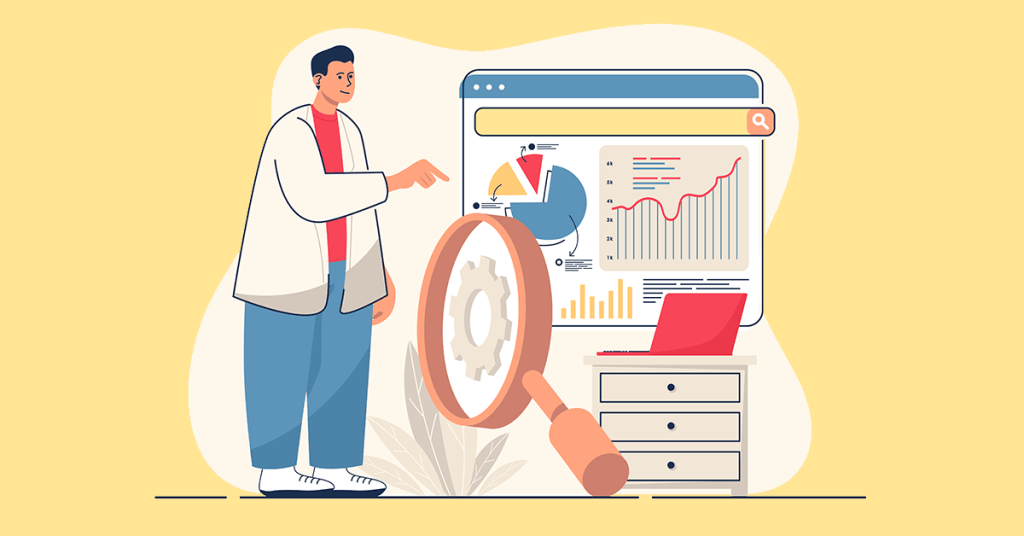These days, few of us can imagine living our lives without social media.
These interactive channels allow us to easily reach out to strangers or friends alike, no matter where they live or who they are. But that is not their only function.
LinkedIn, for example, takes the ease of communication typical for SM platforms and turns it into a valuable tool to boost people’s careers.
[playht_player width=”100%” height=”175″ voice=”Mark”]
Hundreds of millions of users use this platform on a regular basis to post their CVs and job opportunities. Most likely, you are in this group if you’re reading this article.
The issue is, with such a high number of people using the site, it might be hard to make your profile visible to potential employees or employers. Fortunately for you, there are ways to improve the ranking of your profile on this platform if you understand the LinkedIn algorithm.
You might think that the LinkedIn algorithm is there to help you find others and the content relevant to you, but this process works both ways.
If you understand well how it works and how to use it, you can boost your visibility among others as well, no matter if your company offers free online fax service, fast-fashion clothing, or Puerto Rican translation work. So without further delay, let’s discuss how your profile affects your search ranking on LinkedIn.

https://www.pexels.com/photo/photo-of-woman-sitting-on-bed-while-using-black-laptop-4458548/
LinkedIn Judges Freshly Posted Content Based on a Number of Factors
The moment your profile submits something, the site’s algorithm starts to inspect your posts and decides their fate using a four-step process.
The First Filter
The initial step involves the algorithm determining the relevance of your post. In essence, when you make your content available on LinkedIn, it is immediately placed into one of the three major groups: spam, low quality, or clear. This takes place no matter if you uploaded an image, text, or long-form material.
LinkedIn explicitly classifies spam as “abusive, harmful, or disruptive messages and content”. That may involve instances of scams or phishing and even specific business offers sent to many users at the same time.
The low-quality content is not as easy to determine. In general, you should focus on staying relevant in terms of topics you wish to post about, being careful not to overuse hashtags, using strong keywords, and formatting your posts, among other things. Doing so will increase the chances of having your post categorized as “clear”, which will have a significant impact on your visibility.
Once the algorithm determines your post type, it moves to the second stage.
The Second Filter
Now that the program has initially judged your post, it’s going to analyze how other users react to the material you just submitted. Your post will become visible to a small audience to determine its potential popularity.
What this means is that the more people like, comment, or share your post, the better. The LinkedIn algorithm will take note of that and use this to further determine whether your post is worthy of widespread attention. But this works both ways – if many people deem your content irrelevant or unacceptable and use the “Hide” option, or even worse, the “Report” function, your submitted image or text may not pass this stage. In the worst-case scenario, your submitted content may even get filtered out by the platform’s algorithm.
The Third Filter
At this moment, the program stops judging your current message directly and focuses more on your posting history. If your profile is determined to be clear of previous spam or low-quality posts, good for you. However, if there are clear signs of undesirable posts previously being submitted, LinkedIn might either display your post to a smaller group of users or even remove it entirely.
The Fourth Filter
If up to this point your post was well received and had good engagement levels, the algorithm gives way to human editors. These professionals take a look at your post and review it not only to determine its viability but also to further improve the algorithm that initially recommended them said content. Unlike on other social media platforms, if what you submitted continues to be well-received, it will get further exposure for a long time. In some cases, it means that certain content posted on LinkedIn is highly visible even weeks after its initial debut.

https://unsplash.com/photos/YDVdprpgHv4
Moreover, there are two metrics that you should be aware of which have a further impact on the visibility of your content. These are:
The Social Selling Index
This factor, otherwise known as SSI, focuses on your effectiveness in establishing your brand and managing your LinkedIn relationships – that is locating and connecting with others. If your SSI is high, your posts have a higher chance of being listed at the top of the feed.
The Dwell Time
This metric concerns the amount of time other users spend looking at the materials you submit. Chances of having your post displayed at the top (indirectly making your profile more visible) increase when this metric gets higher, so remember to make your content as interesting and fun to engage with as possible.
Now you understand how the LinkedIn algorithm judges your uploaded content. Bear in mind, however, that there is more that can be done to make your profile rank better.

https://unsplash.com/photos/mcSDtbWXUZU
Your Profile Benefits From the Right Keywords
Just like in search engine optimization, having a good selection of keywords included on your LinkedIn page can be very advantageous to your visibility. You should use them in certain sections, such as the headline, experience, and skills parts of your profile. However, you shouldn’t simply fill them with dozens of keywords, but rather, do proper research and select the ones most relevant to what you do.
First of all, focus on your job title. Try to find a keyword that specifically describes the sort of work you do. To illustrate the point, instead of writing down something vague like “experienced IT developer”, be more specific and give your full title, e.g., “Senior Java Front-end Developer”. This way, more interested people will be able to easily find your profile, boosting your chances of either landing a job or making valuable connections.
It’s also important to use keywords related to your region or city. LinkedIn might recognize this and increase your profile visibility among users located near your physical location, making the job-related search easier for all sides. After all, if you don’t consider remote work as a viable approach for employees/employers, you want more visitors from the immediate area of your business, not from the other side of the world.
Don’t forget about including keywords that are highly relevant to the industry you are representing. To give you an example, if you run an online shop, remember to include the “eCommerce” keyword in your descriptions to attract the right audience to your profile.
The Pictures on Your Profile Matter a Lot
In many cases, all it takes for people to get a first impression of someone is to look at them for a split second. Because of that, it’s crucial that your LinkedIn profile has a profile picture that embodies competence and trustworthiness even at first glance. That’s important because the less professional you look, the higher the chances of users ignoring or closing your profile without reading important information on it. That means fewer people exposed to your posts and therefore a lower overall search ranking.
The key here is to avoid a typical selfie look found on many other social media platforms like Facebook or Instagram. What you should focus on is getting a close, unobstructed shot of your smiling face first and foremost. Moreover, you should avoid wearing any sort of sunglasses, as others might subconsciously think you have something to hide and therefore consider you less dependable. Moreover, make sure that you’re wearing clothes appropriate for professionals – your favorite hoodie might look amazing but to many, it may signify a lack of professionalism. Finally, make sure that your face takes up at least 60% of your selected profile picture, if possible.

https://unsplash.com/photos/AMSLWjFhivg
Prioritize Your Connections
One of the important elements affecting the search ranking of your LinkedIn profile is the connections you have. This network is built up by sending invitations to other members and can be divided into three major categories:
First Degree Connections
Those are the people who either accepted your invitation or had theirs accepted by you, making them directly connected to your profile. They can be contacted using messaging functions of the platform and recognized by a special icon.
Second Degree Connections
These users are not specifically your connections but rather those of your first-degree connections. You can send them an invitation using the “Connect” button on the profile. You can recognize them by a special icon displayed in the search results.
Third Degree Connections
These users are connected to your second-degree connections. Similar to the cases above, they also have their own icon.
Connections that you have are vital because LinkedIn search results don’t display random users but rather only those that belong to one of these categories. This process works both ways, meaning that the more connections you have, the more users will be able to locate your profile. Moreover, the search results are not sorted based on the quality of the connection. That means your profile can still be displayed on top even if someone has you as a mere third-degree connection.
Make Sure That Your Profile Is Active on a Regular Basis
To put it simply, activity on LinkedIn is tied to your visibility. If you stop posting content for a longer period of time, your LinkedIn profile will most likely be listed lower in the search results. To further increase the visibility of your posts and, therefore, the exposure of your profile, you might want to follow certain guidelines when it comes to submitting your content.
First of all, focus your posting efforts on Thursdays, Saturdays, and Sundays, as these days usually have the highest average of total views during the week. What’s more, it might be a good idea to make your content easy to read. The same study suggests that your writing style should be easy to understand to all of your readers.
When posting your content on LinkedIn, make sure to include a certain number of pictures alongside your text. To give you an example, adding 8 images to your post results in by far the most viewable content on the platform, with an average of over 57000 views, while the second-best result is 11 images, resulting in over 33000 engagements per post. Videos, on the other hand, aren’t as popular on the platform – the posts with the most views tend not to have them.
Join Various Groups
LinkedIn Groups give you the opportunity to meet other professionals within the same industry or areas of interest. Participating in such groups will allow you to build connections and relationships with other members more easily, making your profile easier to search for a larger number of users. Once your profile becomes a part of such a group, remember to interact with posts made by other members as much as possible to increase your ranking even further.
As you can see, making your profile better ranked on LinkedIn is not necessarily hard nor complicated. You need to remember about the impact of the platform’s algorithm on your posts to make sure it’s as visible as possible. Moreover, it’s never a bad idea to understand the various metrics influencing the placement of your posts in the feed.
Be sure to have a professional-looking profile picture to appear more trustworthy and dependable and make a better first impression. Make sure to get the keywords right in all the relevant sections of your LinkedIn profile. Furthermore, prioritize getting more connections, joining LinkedIn groups of like-minded individuals, and keeping your profile regularly active. Hopefully, with these tips, your profile’s search ranking will improve like never before.

